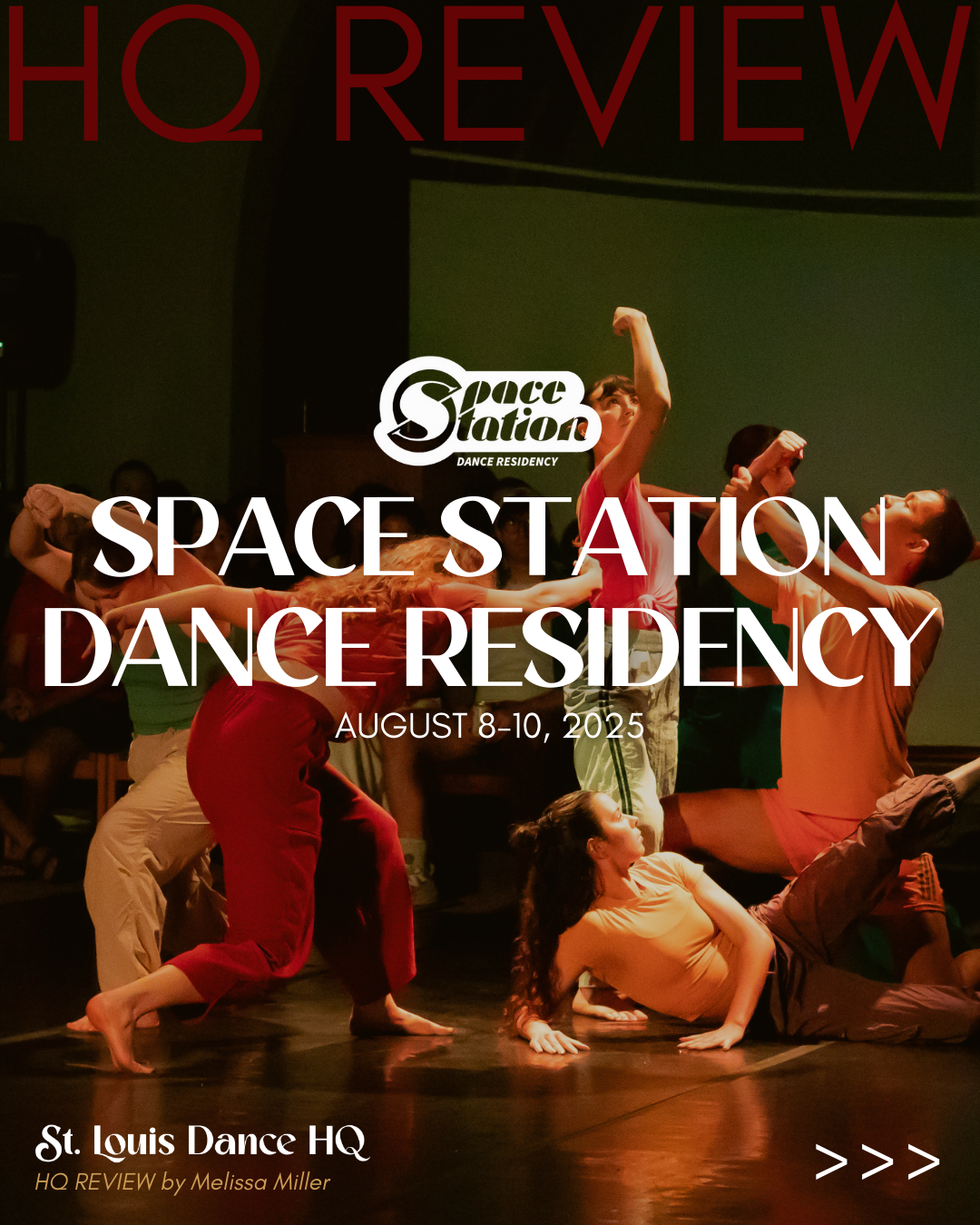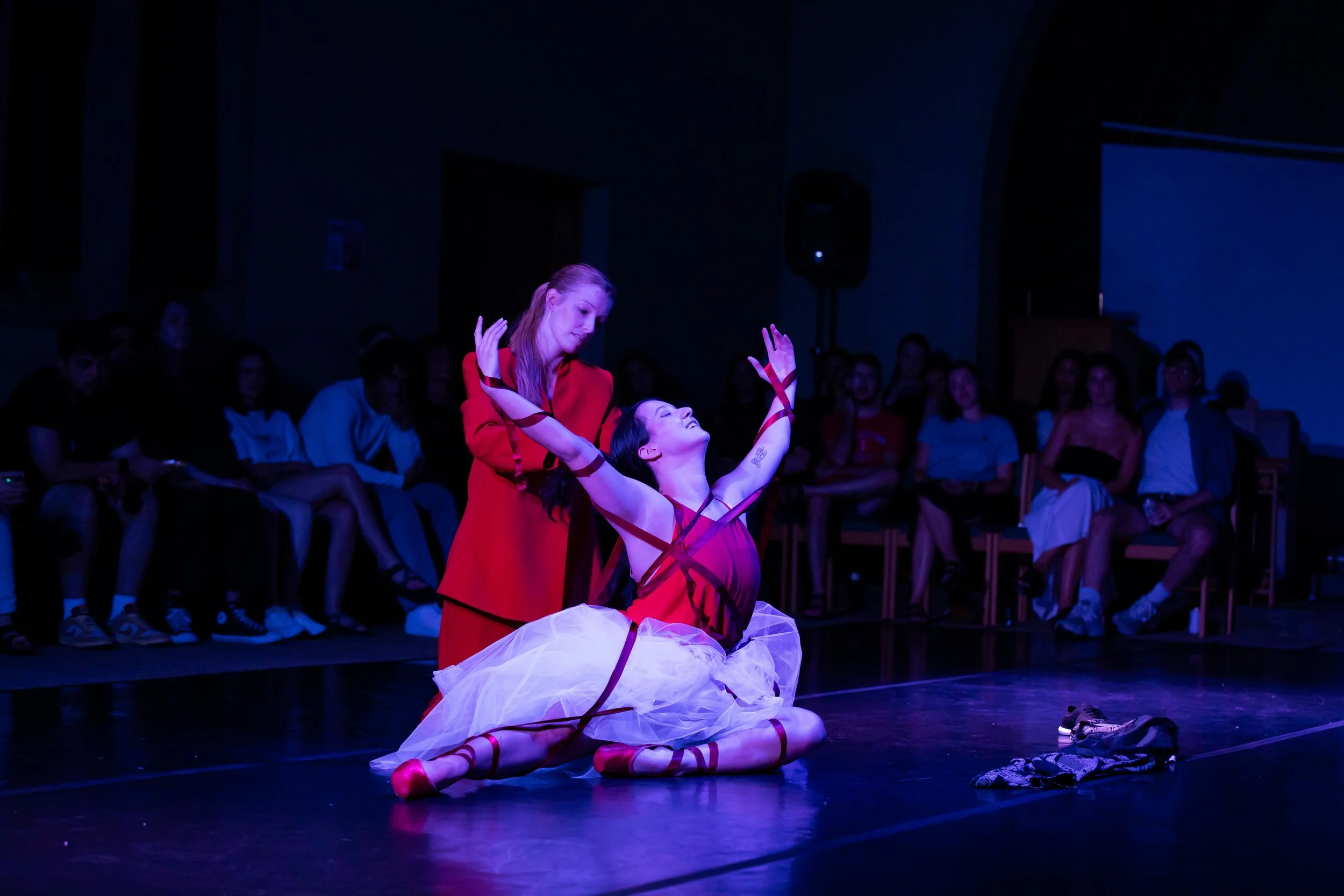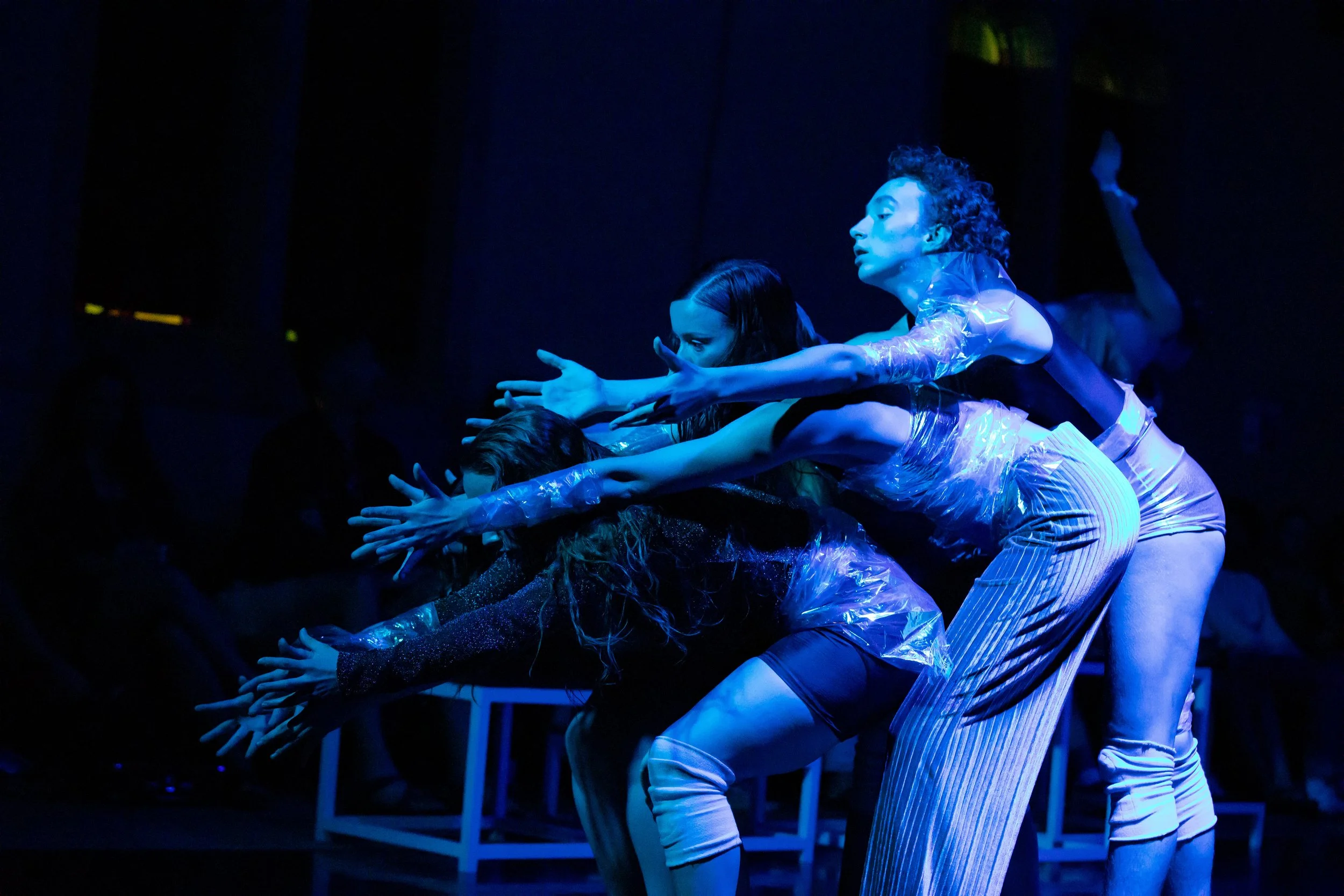HQ Review: Space Station Dance Residency
Space Station, an annual dance residency showcasing experimental works, featured seven choreographers and six new pieces this year, including two guest artists from out of state. The 2025 edition had a special focus on audience participation, deployed in a variety of ways by the evening’s artists. In a pre-show video, viewers were even given instructions on how to decline performer interactions—simply by shaking our heads.
The evening opened with Third Party by Mady Buerck, performed by Delainey Bailey, Elyzah Gasmen, and Lexie Hoehn. The audience shaped the performance’s narrative: two dancers in earth tones formed the core relationship, while a third acted as our proxy, manipulating them according to our votes. Periodically, blue light flooded the stage, and a voice prompted, “Please vote.” Our responses—ranging from “everything turns to jello” to “they make up”—appeared onscreen. In the end, we chose “the world to end,” and a performer clapped her hands; the dancers collapsed as the lights went out. Third Party offered commentary on agency in performance, turning the usual passivity of an audience on its head. It was an impressive feat of choreography and performance, with the cast being familiar with ten possible outcomes.
Ally Lamkie’s solo Perhaps began with a voice announcing, “I will be leading you through your guided hypnosis.” As Ally snaked her way across the stage, head and eyes down with slow, deliberate steps around the room, the voice encouraged us, among other things, to close our eyes. We were assured not to worry, that she would tell us when it was all over. The encouragement to close our eyes created an enjoyable conundrum for the audience. Should we obey? Weren’t we supposed to be watching—wasn’t that our only job? Ally continued to circle the stage, occasionally erupting into sudden, violent drops to the floor. As the hypnosis track glitched and slowed, she snapped her fingers, breaking the spell.
In The Fruits of Her Labor, Chrissy Clair and Abbi LeBaube staged an ode to sexual awakening—or perhaps a brief utopia of earnest commitment and youthful exploration. In the opening moments, Abbi dropped fruit from her dress into a wash bucket as Chrissy knelt to clean it, wind chimes sounding. This slow beginning ramped up to a wild investigation of texture, sound, and taste: cherries, apples, and citrus fruits were crushed, eaten, rolled on, squashed under toes, thrown, and sprayed out of the dancers' mouths (landing on several unsuspecting audience members). The dancers handed out bananas and condoms before asking some members to line up and bob for apples in the wash bucket. It ended tenderly, with Chrissy washing Abbi’s hair as the chimes returned.
Elinor Harrison’s Utterance opened Act Two in silence. Dancers Zoe DeYoung, Sam Fink, Josaiah Gunderson, Abbie Hinrichs, Ramona Orion, and Paige Van Nest, all brightly dressed, entered and clustered together in architectural poses. They stayed perfectly still until Abbie broke away, looking over her shoulder to wave casually at the audience before finally walking off to crouch down, engaging an audience member in a quiet chat. The other dancers shifted their gaze as their poses faltered. Abbie returned to the group, and the dancers let out a collective sigh, which broke them apart. They scattered across the stage and froze into silence again. In the lull, Zoe lifted her head: “What?” she asked. Ramona, the only dancer in her line of sight, relaxed her pose to respond, “I didn’t say anything.” This simple and clever device—continuously building and breaking form, and with it the audience's expectations—continued throughout the piece, making for an effective and engaging work. A standout duet between Josiah and Ramona saw her hand placed firmly over his mouth as she egged him on: “I don’t get it. Spit it out, I need you to spit it out! Are you ready? Spit it out!” As the two tried and failed to communicate, they flailed and bounced off each other’s bodies, blending tense antagonism with slapstick in an expertly crafted work.
Guest artist Sarah Yvonne’s Shoes: Evolution of a Dancer, performed by Lillian Berry and Laura Roth, followed. In bright red, arms full of costumes, they entered the stage. Shoes told a story of a tender search for identity and longing for acceptance. The costumes and various dance shoes served as gateways, ushering the dancers—as they cycled through them—into different eras and styles of dance while “Creep” and “Let’s Dance” played from the record player. When Lillian donned red pointe shoes, Laura bound her with their ribbons, braiding them into her long, dark hair. Realizing too late that she was entrapped, Lillian was briefly dragged across the floor by her hair before breaking free from Laura and the red strands enclosing her body. Shoes balanced a dreamlike atmosphere with straightforward storytelling and a tender, empathetic connection between its performers.
The final piece was by guest artist Kara Beadle in collaboration with dancers Marlee Doniff, Alivia Fletcher, Taylor Lee, Melissa Miller, Chloe Roberts, and Morgan Van Nest. In Wreck, metallic dancers wrapped in varying amounts of cellophane entered the stage, rattling, crinkling, and climbing onto boxes of various heights set around the space. Movement shifted from sharp jolts to spasmodic shaking, then to gyrating to pulsing beats. A remote-controlled car zoomed onto the stage, metallic and with small bright headlights. The dancers responded to the car with uncanny empathy, chasing it around the space until Marlee caught it in her arms and walked from the room, cradling it lovingly. The dancers encouraged the audience to “get in the car” and proceeded to line us up before gleefully ushering us out of the space into another chapel, where a wedding between Marlee and the remote-controlled car was taking place. Witnesses at first, the dancers eventually sank to the floor as Marlee turned to reveal her own headlight-like eyes glowing.
Now in its sixth year, Space Station remains a vital hub for experimental performance in St. Louis, fulfilling its mission to “share space and ideas and invigorate each other.” The residency continues to offer artists a space to take risks and audiences the chance to encounter dance in unexpected, thrilling ways.








